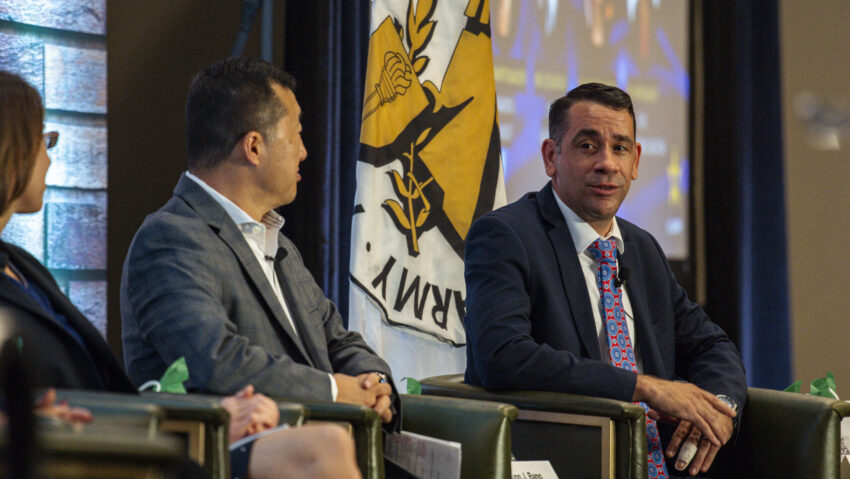Mr. Leonel Garciga, the U.S. Army Chief Information Officer, addresses the moderator and members of the panel during the Under Secretary of the Army’s Digital Transformation Panel at the Walter E. Washington Convention Center in Washington, D.C., Sept. 10, 2023. (US Army photo by Henry Villarama)
WASHINGTON — Artificial intelligence is a powerful but dangerous tool, the Army CIO told Breaking Defense, so a big part of his job now is making sure it’s safe to use.
Widely available Large Language Models have already proven they can save hundreds of hours and millions of dollars for Army personnel struggling through complex paperwork, Leonel Garciga said. But, at the same time, he emphasized, the Army must adopt such off-the-shelf AI carefully by ensuring it protects military secrets, sensitive personal information, proprietary contractor data, and the public’s right to know.
“I just signed … our FOIA [Freedom of Information Act] and records management policy, which has been updated now specific to AI,” Garciga told Breaking Defense.
“If you’re using an AI tool, it doesn’t absolve you from meeting those requirements,” he said. “I still have a responsibility to the American public to provide FOIA, right? I still have a responsibility to make sure that we’re adhering to both federal government and DoD record-management policies. So we wanted to make sure that we baked [that] in.”
That philosophy drove Army officials to block access to some earlier government implementations of generative AI — including the Air Force Research Laboratory’s NIPRGPT — after the service’s own Army Enterprise LLM Workspace went online in May. (The Workspace was subsequently endorsed by the Pentagon’s Chief Digital and AI Office for use by joint HQs worldwide).
“In April, we did make a fundamental decision on access to NIPRGPT, and they were not just [the only] one,” Garciga said. The ban was not meant as “pejorative” or as any indictment of the hard work done to build these “first wave” government GenAIs, he emphasized: They played a valuable role in exposing federal employees to LLMs and giving them a chance to explore both its potential and its pitfalls.
“It was the first wave, it got hands on keyboard, it got experience,” Garciga said. “It was great for training, but the security posture wasn’t where we felt comfortable … especially when we’re talking about both processing PII [personally identifiable information] and, in a couple of instances, sensitive contract data.”
Fortunately, Garciga argued, the commercial AI world has already put a lot of energy into making GenAI safer, more secure, and better at keeping the records required for accountability, transparency and oversight. So, he said, as with the core technology of LLMs themselves, there’s no need for the government to invest taxpayer dollars in reinventing the wheel.
“We act like it’s a kind of a federal government-only or DoD-only challenge,” Garciga said. “[But] if you look in the commercial space, whether you’re a bank, whether you’re a health care provider [or] drug manufacturer, you know, we’re all challenged with the same thing, right? We have federally mandated requirements for us to be able to understand how our data is being used and who our data is being exposed to.”
In fact, he said, “I think we’re a little bit behind the curve in the federal space right now. … We haven’t updated our legislation or policies to reflect the advent and the deployment of LLMs in our environment.”
So the service is striving to catch up. The roll-out of the new Enterprise LLM Workspace and the signing of the new FOIA and record-management policy are parts of a larger effort, Garciga said. In particular, he said, while he’s confident in the LLM Workspace, the Army’s still working to ensure compliance across all its different software suites — Palantir, SAP, Salesforce, and so on — which have been independently integrating GenAI features of their own.
“Everybody’s doing that a little bit differently,” Garciga said. “We have been working directly with the vendors … and with our contract folks [on] changing our service-level agreements” to ensure Army data stays secure and that all the proper safeguards are turned on.
“I’m sure we’re going to miss some things,” he said frankly. “The Army’s big, you know. We’ve got a lot of programs and a lot of things happening. So our big push is to make sure we get the word out. … We really do spend a lot of time protecting the Army’s data.”
Click this link for the original source of this article.
Author: Sydney J. Freedberg Jr.
This content is courtesy of, and owned and copyrighted by, https://breakingdefense.com and its author. This content is made available by use of the public RSS feed offered by the host site and is used for educational purposes only. If you are the author or represent the host site and would like this content removed now and in the future, please contact USSANews.com using the email address in the Contact page found in the website menu.








